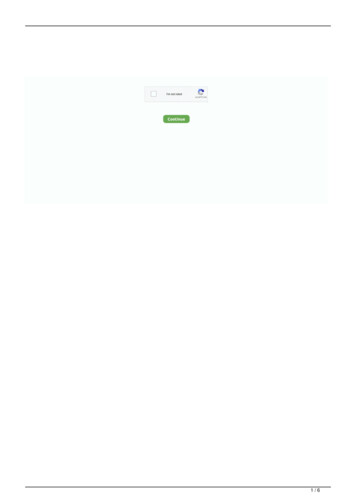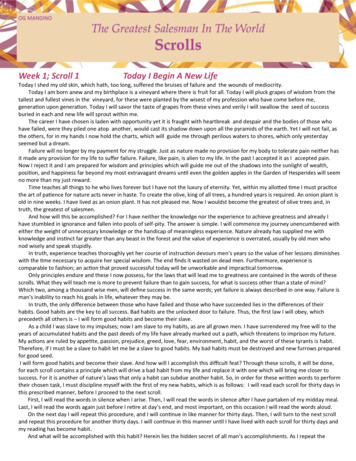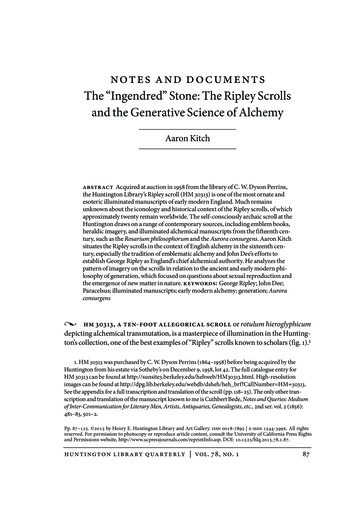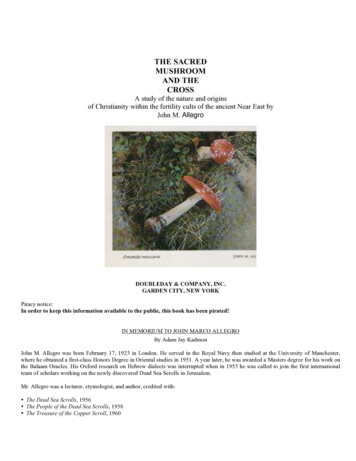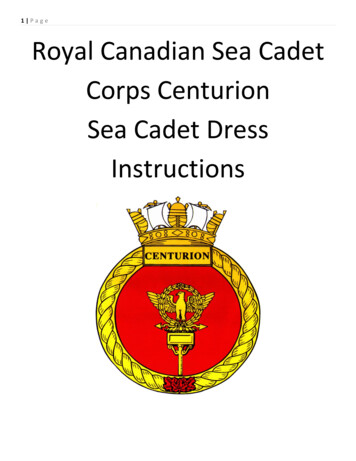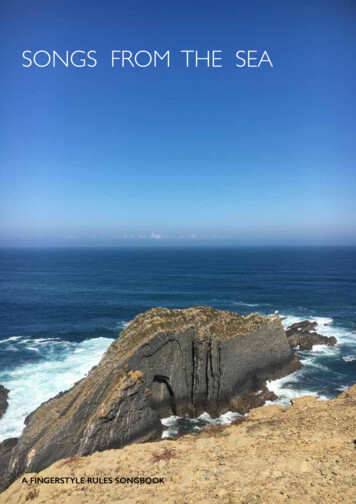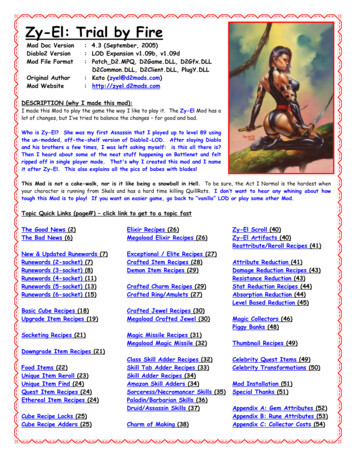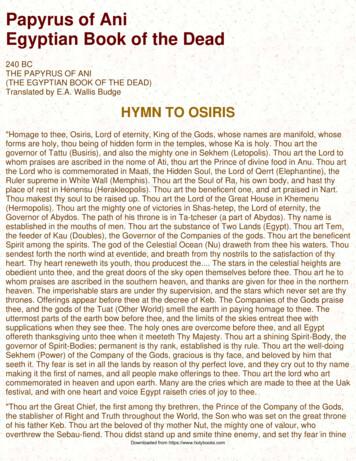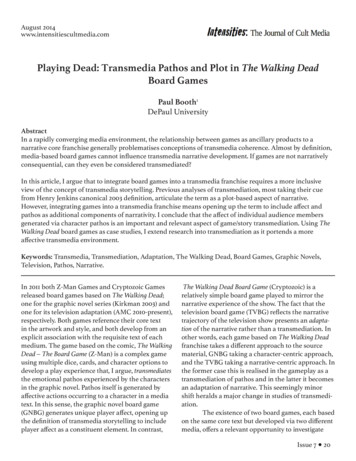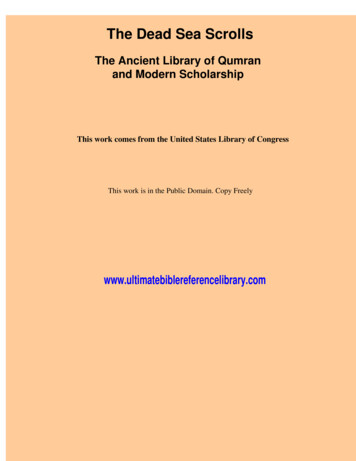
Transcription
The Dead Sea ScrollsThe Ancient Library of Qumranand Modern ScholarshipThis work comes from the United States Library of CongressThis work is in the Public Domain. Copy Freelywww.ultimatebiblereferencelibrary.com
Table of Contents About this ExhibitIntroduction The World of the Scrolls The Dead Sea Region Scrolls The Psalms Scroll Artifacts from the Qumran Site Scroll Jar - Textiles - Leather Scroll Fastenings Related Library of Congress MaterialsThe Qumran Community The Late Second Temple Period The Qumran Community Scrolls The Phylactery Scroll - The Community Rule Scroll - The Calendrical DocumentScroll - The Torah Precepts Scroll Artifacts from the Qumran Site Phylacteries - Wood - Pottery - Basketry & Cordage - Leather - Stone - Coins Related Library of Congress MaterialsThe Qumran Library The Qumran Library Scrolls The Enoch Scroll - The Hosea Commentary Scroll - The Prayer For King JonathanScroll - The Leviticus Scroll - The Sabbath Sacrifice Scroll Artifacts from the Qumran Site Pottery Inkwell Related Library of Congress MaterialsTwo Thousand Years Later Two Thousand Years Later Judaism & Christianity & the Dead Sea Scrolls Scrolls The Damascus Document Scroll - The War Rule Scroll Related Library of Congress MaterialsConclusionBibliographies Selected Readings Resource Materials for Teachers
GlossaryExhibit BrochureArtcle About the Dead Sea Scroll Exhibit (Includes a bibliography)Credits
Scrolls From the Dead Sea:The Ancient Library of Qumran and Modern ScholarshipABOUT THIS EXHIBITThe exhibition Scrolls From the Dead Sea: The Ancient Library of Qumran and ModernScholarship brings before the American people a selection from the scrolls which have been the subjectof intense public interest. Over the years questions have been raised about the scrolls' authenticity, aboutthe people who hid them away the the period in which they lived, about the secrets the scrolls mightreveal, and about the intentions of the scrolls' custodians in restricting access. The Library's exhibitiondescribes the historical context of the scrolls and the Qumran community from whence they may haveoriginated; it also relates the story of their discovery 2,000 years later. In addition, the exhibitionencourages a better understanding of the challenges and complexities connected with scroll research.The goals of the "Scrolls from the Dead Sea" exhibition are three fold: to enable visitors to see twelve ofthe Dead Sea Scroll fragments; to promote greater understanding of the turbulent period in which theDead Sea Scrolls were copied; and to provide some insight into the questions raised and the "mystery"surrounding this great manuscript find.The exhibit has an introductory as well as three main sections:The introductory area presents the Psalms Scroll, the largest of the scroll fragments in the exhibition,and touches on the geographical and religious contexts of the period."The Qumran Community" examines the region in which the scrolls were found, presents thearchaeological materials uncovered at the Qumran site, and explores the nature of the habitation adjacentto the scroll-bearing caves.The "Qumran Library" is a look at the various scrolls that were discovered in the Dead Sea caves."Two Thousand Years Later" explores the significance of the scrolls to modern scholarship and presentssome of the questions and controversies that surround them.The storyline for the exhibition includes not only interpretation of the scrolls, their meaning and
significance, it also deals, to the extent it has been explored by scholars, with the history and socialrealities of the people and the times that produced the scrolls. Recent publications on the exhibitedscrolls are included throughout the exhibition. Finally, the exhibition presents differing views wherethey occur. For example, the Qumran excavation is viewed by many as the site of a communal religioussect, probably the Essenes. The exhibition explores this interpretation but also presents entirely differentpoints of view.In the exhibition, B.C.E. (Before the Common Era) and C.E. (Common Era) are alternate designationsfor B.C. and A.D. The exhibition contains other words, terms, and references that may need definition orexplanation. Such terms are explained the first time they occur in the exhibition. This online exhibitincludes a full glossary of such terms as well as the exhibit brochure.Go to the Next Section of Scrolls from the Dead SeaTable of Contents
Scrolls From the Dead Sea:The Ancient Library of Qumran and Modern ScholarshipTHE WORLD OF THE SCROLLSIn 1947, young Bedouin shepherds, searching for a stray goat in the Judean Desert, entered a longuntouched cave and found jars filled with ancient scrolls. That initial discovery by the Bedouins yieldedseven scrolls and began a search that lasted nearly a decade and eventually produced thousands of scrollfragments from eleven caves. During those same years, archaeologists searching for a habitation close tothe caves that might help identify the people who deposited the scrolls, excavated the Qumran ruin, acomplex of structures located on a barren terrace between the cliffs where the caves are found and theDead Sea. Within a fairly short time after their discovery, historical, paleographic, and linguisticevidence, as well as carbon-14 dating, established that the scrolls and the Qumran ruin dated from thethird century B.C.E. to 68 C.E. They were indeed ancient! Coming from the late Second Temple Period,a time when Jesus of Nazareth lived, they are older than any other surviving manuscripts of the HebrewScriptures by almost one thousand years.Since their discovery nearly half a century ago, the scrolls and the identity of the nearby settlement havebeen the object of great scholarly and public interest, as well as heated debate and controversy. Whywere the scrolls hidden in the caves? Who placed them there? Who lived in Qumran? Were itsinhabitants responsible for the scrolls and their presence in the caves? Of what significance are thescrolls to Judaism and Christianity?This exhibition presents twelve Dead Sea Scroll fragments and archaeological artifacts courtesy of theIsrael Antiquities Authority as well as supplementary materials from the Library of Congress. It isdesigned to retell the story of the scrolls' discovery; explore their archaeological and historical context;introduce the scrolls themselves; explore the various theories concerning the nature of the Qumrancommunity; and examine some of the challenges facing modern researchers as they struggle toreconstruct the scrolls from the tens of thousands of fragments that remain.Go to the Next Section of Scrolls from the Dead SeaTable of Contents
Scrolls From the Dead Sea:The Ancient Library of Qumran and Modern ScholarshipTHE DEAD SEAThe Dead Sea is located in Israel and Jordan, about 15 miles east of Jerusalem. It is extremely deep(averaging about 1,000 feet), salty (some parts containing the highest amount of salts possible), and thelowest body of water in the world. The Dead Sea is supplied by a number of smaller streams, springs,and the Jordan River.Because of its low elevation and its position in a deep basin, the climate of the Dead Sea area is unusual.Its very high evaporation does produce a haze yet its atmospheric humidity is low. Adjacent areas to itare very arid and favorable for the preservation of materials like the Dead Sea Scrolls.The Bible's description, in Genesis 19, of a destructive earthquake near the Dead Sea area during thetime of Abraham is borne out by archaeological and historic investigation. While no evidence remains ofthe five cities of the plain (Zeboim, Admah, Bela or Zoar, Sodom, and Gomorrah) their sites arebelieved to be beneath the waters at the southern end of the sea.Archaeological sites near the Dead Sea include Masada, Ein Gedi, and Qumran (where the Dead SeaScrolls were found).Map of the Dead Sea RegionGo to the Next Section of Scrolls from the Dead SeaTable of Contents
Scrolls From the Dead Sea:The Ancient Library of Qumran and Modern ScholarshipINTRODUCTION:SCROLLSThis scroll fragment was displayed in the exhibit at the Library of Congress, May-August 1993. It wasprovided courtesy of the Israel Antiquities Authority. The exhibit caption and translation providebackground on the fragment and its relationship with the other Dead Sea Scrolls, the QumranCommunity, and its Library.The Psalms ScrollThe Psalms Scroll (black & white)The Psalms Scroll (color)The Psalms Scroll (color, with transcription)Translation of the Psalms ScrollTehillim11QPsParchmentCopied ca. 30 - 50 C.E.Height 18.5 cm (7 1/4 in.), length 86 cm (33 3/4 in.)Courtesy of the Israel Antiquities Authority (5)This impressive scroll is a collection of psalms and hymns, comprising parts of forty-one biblical psalms(chiefly form chapters 101-50), in non-canonical sequence and with variations in detail. It also presentspreviously unknown hymns, as well as a prose passage about the psalms composed by King David.
One of the longer texts to be found at Qumran, the manuscript was found in 1956 in Cave 11 andunrolled in 1961. Its surface is the thickest of any of the scrolls--it may be of calfskin rather thansheepskin, which was the more common writing material at Qumran. The script is on the grain side ofthe skin. The scroll contains twenty-eight incomplete columns of text, six of which are displayed here(cols. 14-19). Each of the preserved columns contains fourteen to seventeen lines; it is clear that six toseven lines are lacking at the bottom of each column.The scroll's script is of fine quality, with the letters carefully drawn in the Jewish book-hand style of theHerodian period. The Tetragrammaton (the four-letter divine name), however, is written in the paleoHebrew script.Reference:Sanders, J. A. The Psalms Scroll of Qumran Cave 11 (11QPs[superscript]a). Discoveries in theJudaean Desert, IV. Oxford, 1965.Go to the Next Section of Scrolls from the Dead SeaTable of Contents
Scrolls From the Dead Sea:The Ancient Library of Qumran and Modern ScholarshipINTRODUCTION:ARTIFACTS FROM THE QUMRAN SITEThese artifacts from the Qumran Site were included in the exhibit at the Library of Congress, May August 1993. They were provided courtesy of the Israel Antiquities Authority. The exhibit captionsprovide background on the objects and their relationship with the Dead Sea Scrolls, the QumranCommunity, and its Library.Scroll JarJar with LidPotteryFirst century B.C.E.-first century C.E.Some of the scrolls found by Bedouin shepherds in 1947 were discovered in cylindrical pottery jars ofthis type, which are unknown elsewhere. Many authorities consider the discovery of these uniquevessels in the Qumran excavations as well as in the caves, as convincing evidence of the link betweenthe settlement and the caves. These jars, like the other pottery vessels recovered at Qumran, wereprobably manufactured locally.KhQ 1474Lid: Height 5 cm (2 in.), diameter 17.8 cm (7 in.)Jar: Height 49.8 cm (19 1/2 in.), diameter 24 cm (9 3/8 in.)Courtesy of the Israel Antiquities Authority (57, 58)
TextilesThe textiles shown here are two out of scores of pieces collected together with scrolls and other objectsfrom the floor of the Qumran Cave 1 in the spring of 1949. The textiles were examined at the H. M.Norfolk Flax Establishment in England, and the material was identified as linen. A total of seventyseven pieces, plain and decorated, were cataloged and described by the renowned textile expert GraceM. Crowfoot.It is possible that all of the cloths found at Qumran are linked with the scrolls. Some of them werecertainly scroll wrappers; the remains of one scroll was found wrapped in a small square of linen. Othercloths, found folded into pads, may have formed a packing for worn-out scrolls inside the scroll jars.Still other pieces--with corners twisted or bound with linen cord--may have been used as protectivecovers, tied over the jar tops.The wrapped scrolls may have been concealed in the cave at a time of national panic or simply buried,as was a common practice, when they wore out. The condition of the cloths would coincide with eithersuggestion.Reference:Crowfoot, G. M. "The Linen Textiles." In Qumran Cave I. Discoveries in the Judaean Desert, I,pp. 18-38. Oxford, 1955.Linen ClothFirst century B.C.E.-first century C.E.This cloth is cut along three sides, rolled and oversewn with a single thread; the fourth edge has a cordedstarting border in twining technique, followed by a woven strip and an open unwoven space. It wasfound folded into a pad and was probably used as packing material for discarded scrolls.7Q, cloth 30Length 35.5 cm (13 7/8 in.), width 24 cm (9 3/8 in.)Counts: 14x14, 13x13, and in one place 16x14 threads per cmCourtesy of the Israel Antiquities Authority (76)Reference:Discoveries in the Judaean Desert, I, pp. 33-34. Oxford, 1955.
Linen ClothFirst century B.C.E.-first century C.E.The edges of this cloth are cut, rolled, and whipped on two opposite sides with single thread. On theother two sides, a double thread was used. Two corners are twisted, and the third has a piece of stringknotting it, indicating that it was probably used as a cover for a scroll jar.1Q, cloth 15Length 29 cm (11 15/16 in.), width 25 cm (9 3/4 in.)Counts: 17x13 threads per cmCourtesy of the Israel Antiquities Authority (75)Reference:Discoveries in the Judaean Desert, I, pp. 33-34. Oxford, 1955.Leather Scroll FasteningsTabsThongsFirst century B.C.E.-first century C.E.Tabs and thongs like these may have been used to bind and secure individual scrolls. The fasteningmethod is thought to consist of a slotted tab folded over the edge of the scroll (see "Prayer for KingJonathan" scroll fragment) with a thong inserted through the tab's slot. The thong then could be tiedaround the scroll. Fasteners were generally made of leather and were prepared in different sizes. Theleather thongs may have also been used in the making of phylacteries.Tabs:length 1.7-2.7 cm (11/16 in.-1 1/16 in.), width 1.4-3.3 cm(9/16 in.-1 5/16 in.)Thongs: length 7-30 cm (2 3/4 in.-11 3/4 in.), width 0.3-0.8 cm(1/8 in.-5/16 in.)Courtesy of the Israel Antiquities Authority (90-100)Reference:Carswell, J. "Fastenings on the Qumran Manuscripts." In Qumran Grotte 4:II. Discoveries in the
Judaean Desert, VI, pp. 23- 28 and plates. Oxford, 1977.Go to the Next Section of Scrolls from the Dead SeaTable of Contents
Scrolls From the Dead Sea:The Ancient Library of Qumran and Modern ScholarshipINTRODUCTION:RELATED LIBRARY OF CONGRESS MATERIALSThese items were on display in the exhibit at the Library of Congress, May - August 1993. Images ofthese objects are not included in the online version of the exhibit, but these exhibit captions are includedto provide some additional background on the scholarly work surrounding the Dead Sea Scrolls, theQumran Community, and its Library.PSALMS SCROLLJ. A. Sanders published his findings on the Psalms Scroll first in 1965, as the fourth volume of"Discoveries in the Judaean Desert," the official publication series. This is a later version published inthe United States.J. A. SandersThe Dead Sea Psalms Scroll (Ithaca, 1967)Printed bookGeneral Collections, Library of Congress (185)THE FIRST HEBREW PRINTED BOOK OF THE BIBLE: THE PSALMSHand-written books of the Bible were found among the Dead Sea Scrolls. This Psalter is the first book
of the Bible printed in Hebrew. This edition of the Psalms includes the commentary of David Kimhi andwas printed in 1477, probably in Bologna. The commentary on the Psalms was heavily censored byChurch authorities. The owner of the book, however, inserted by hand each word that had beenexpunged.Psalms (Bologna, 1477)Printed bookHebraic Section, African and Middle Eastern Division, Library of Congress (190)THE ALEPPO CODEXUntil the discovery of the Dead Sea Scrolls in 1947, the Aleppo Codex, which dates to the tenth centuryC.E., was the oldest known Bible codex. This facsimile was published in 1976.Aleppo Codex (Jerusalem, 1976)Printed bookHebraic Section, African and Middle Eastern Division, Library of Congress (117)THE COMPLUTENSIANThis is the earliest of the great polyglot editions of the Bible and includes texts in Hebrew, Aramaic,Greek, and Latin. Produced under the patronage of Cardinal Francisco Ximenes de Cisneros (14361517), it was believed to have cost 50,000 gold ducats. Psalm 145 is a hymn arranged according to theletters of the Hebrew alphabet. It is interesting to note that today's biblical text does not include a versefor the letter "nun," the fourteenth letter of the alphabet. The fragment of the Psalm Scroll displayed heredoes include a missing verse for this letter.Psalms [Complutensian] (1514-1517)Printed polyglot bibleRare Book and Special Collections Division, Library of Congress (177)
THE DEAD SEA LOOKING TOWARDS MOABIn 1838-1839, Scottish artist David Roberts (1796-1864) traveled through the Near East, bringing home300 sketches of monuments and landscapes that he encountered on his journey. His drawings werereproduced in six volumes between 1842-1849.Shown here is his rendering of "The Dead Sea Looking Towards Moab." In the foreground--carved intothe rocky cliff--is the monastery of St. Saba.David Roberts"Dead Sea Looking Towards Moab, April 4, 1839"The Holy Land (London, 1842-1849)Lithograph with hand-coloringPrints and Photographs Division, Library of Congress (163)VIEWS OF JERUSALEMThis map is the lower of two plates depicting Jerusalem. The Temple of Solomon, located at the top ofthe map, includes illustrations of the High Priest at the altar. The Ark of the Covenant is located in theHoly of Holies (the innermost chamber of the Temple), with God's spirit, the "Shekhinah," emanatingfrom the ark and represented by the Tetragrammaton, the four- letter divine name.Georg Braun and Franz Hogenberg"Jerusalem"Civitates Orbis Terrarum (Cologne, 1612)Printed book, hand-colored etchingGeography and Map Division, Library of Congress (168)VIEWS OF THE HOLY LANDThis hand-colored map of the Holy Land (Terra Sancta) features an enlarged depiction of the Dead Sea.On the lower left of the map is a rendering of the story of Jonah and the whale.
Abraham Ortelius"Terra Sancta"Theatrum Orbis Terrarum (London, 1606)Printed bookGeography and Map Division, Library of Congress (167)VIEWS OF THE HOLY LANDClaudius Ptolemy (90-168 C.E.) was the preeminent geographer of the ancient world. Shown here is ahand-colored map of the Holy Land from a 1482 Ptolemaic atlas. The territories of the twelve tribes ofIsrael are clearly marked throughout.Claudius PtolemaeusCosmographia (Ulm, 1486)Printed book, hand-colored woodcutGeography and Map Division, Library of Congress (166)BIRD'S-EYE VIEW OF THE HOLY LANDThis aerial perspective of the Holy Land reflects a nineteenth- century trend in American mapmakingwhich featured "bird's-eye" views prepared for towns and cities across the nation. Published in NewYork, the rendering of the Holy Land indicates the intense American interest in this part of the world.A. J. MarksBird's Eye View of the Holy Land (New York, 1879)Chromolithograph, sectional map in 6 partsGeography and Map Division, Library of Congress (169)Go to the Next Section of Scrolls from the Dead SeaTable of Contents
Scrolls From the Dead Sea:The Ancient Library of Qumran and Modern ScholarshipTHE LATE SECOND TEMPLE PERIOD (200 B.C.E.- 70 C.E.)In 168 B.C.E., the Maccabees (or Hasmoneans), led by Judah Maccabee, wrested Judea from the rule ofthe Seleucids--Syrian rulers who supported the spread of Greek religion and culture. The Jewish holidayof Hanukkah commemorates the recapture of Jerusalem by the Maccabees and the consecration of theTemple in 164 B.C.E. The Maccabees ruled Judea until Herod took power in 37 B.C.E.Contemporary historian Flavius Josephus divided Judeans into three main groups:Sadducees:The Sadducees were priestly and aristocratic families who interpreted the law more literally thanthe Pharisees. They dominated the Temple worship and its rites, including the sacrificial cult. TheSadducees only recognized precepts derived directly from the Torah as binding. They, therefore,denied the concept of the immortality of the soul, the resurrection of the body, and the existenceof angels. The Sadducees were unpopular with the common people.Pharisees:The Pharisees, unlike the Sadducees, maintained the validity of the oral as well as the writtenlaw. They were flexible in their interpretations and willing to adapt the law to changingcircumstances. They believed in an afterlife and in the resurrection of the dead. By the firstcentury C.E., the Pharisees came to represent the beliefs and practices of the majority ofPalestinian Jewry.Essenes:The Essenes were a separatist group, some of whom formed an ascetic monastic community andretreated to the wilderness of Judea. They shared material possessions and occupied themselveswith disciplined study, worship, and work. They practiced ritual immersion and ate their mealscommunally. One branch did not marry.
In 6 C.E., Rome formed Judea, Samaria, and Idumea into one province governed by procurators. AJudean revolt against Rome in 66 C.E. was quickly put down. Qumran fell to the Roman legions in ca.68 C.E., the Temple in 70 C.E., and Masada in 73 C.E.Go to the Next Section of Scrolls from the Dead SeaTable of Contents
Scrolls From the Dead Sea:The Ancient Library of Qumran and Modern ScholarshipTHE QUMRAN COMMUNITYLike the scrolls themselves, the nature of the Qumran settlement has aroused much debate and differingopinions. Located on a barren terrace between the limestone cliffs of the Judean desert and the maritimebed along the Dead Sea, the Qumran site was excavated by Pere Roland de Vaux, a French Dominican,as part of his effort to find the habitation of those who deposited the scrolls in the nearby caves. Theexcavations uncovered a complex of structures, 262 by 328 feet which de Vaux suggested werecommunal in nature. In de Vaux's view the site was the wilderness retreat of the Essenes, a separatistJewish sect of the Second Temple Period, a portion of whom had formed an ascetic monasticcommunity. According to de Vaux, the sectarians inhabited neighboring locations, most likely caves,tents, and solid structures, but depended on the center for communal facilities such as stores of food andwater.Following de Vaux's interpretation and citing ancient historians as well as the nature of some scroll textsfor substantiation, many scholars believe the Essene community wrote, copied, or collected the scrolls atQumran and deposited them in the caves of the adjacent hills. Others dispute this interpretation, claimingeither that the scroll sect was Sadducean in nature; that the site was no monastery but rather a Romanfortress or a winter villa; that the Qumran site has little if anything to do with the scrolls; or that theevidence available does not support a single definitive answer.Whatever the nature of the habitation, archaeological and historical evidence indicates that the excavatedsettlement was founded in the second half of the second century B.C.E., during the time of theMaccabees, a priestly Jewish family which ruled Judea in the second and first centuries B.C.E. A hiatusin the occupation of the site is linked to evidence of a huge earthquake. Qumran was abandoned aboutthe time of the Roman incursion of 68 C.E., two years before the collapse of Jewish self-government inJudea and the destruction of the Temple in Jerusalem in 70 C.E.Go to the Next Section of Scrolls from the Dead SeaTable of Contents
Scrolls From the Dead Sea:The Ancient Library of Qumran and Modern ScholarshipTHE QUMRAN COMMUNITY:SCROLLSThese scroll fragments were displayed in the exhibit at the Library of Congress, May - August 1993.They were provided courtesy of the Israel Antiquities Authority. The exhibit captions and translations(below) provide background on the fragments and their relationships with the other Dead Sea Scrolls,the Qumran Community, and its Library.The Phylactery ScrollThe Phylactery Scroll (black & white)The Phylactery Scroll (color)Translation of the Phylactery ScrollTefillinMur 4 PhylParchmentCopied first century-early second century C.E.Fragment A: height 17.7 cm (7 in.), length 3 cm (1 3/16 in.)Fragment B: height 3.8 cm (1 1/2 in.), length 2.8 cm (1 1/8 in.)Courtesy of the Israel Antiquities Authority (3)The command "And thou shalt bind them for a sign upon thy hand, and they shall be for frontletsbetween thine eyes" (Deut. 6:8) was practiced by Jews from early times. In the Second Temple periodthe sages established that "tefillin" (phylacteries; amulets in Greek) would include four scripturalpassages inscribed on parchment placed in box-like containers made of black leather. One of the
phylacteries was worn one on the left arm and the other on the forehead. These served "as a sign uponyour hand and as a symbol on your forehead that with a mighty hand the Lord freed us fromEgypt" (Exodus 13:9, 16).The Dead Sea region has now yielded the earliest phylactery remains, both of the leather containers andthe inscribed strips of parchment. As a rule, phylacteries include the same four selections, two from thebook of Exodus (Exod. 13:1-10; 13:11-16) and two from Deuteronomy (Deut. 6:4-9; 11:13-21). Thescriptural verses were penned in clear minuscule characters on the elongated writing material, which wasfolded over to fit the minute compartments stamped into the containers.References:Milik, J. T. "Textes Hebraux et Arameens." In Les Grottes de Murabba at, Discoveries in theJudaean Desert, II, pp. 80- 85. Oxford, 1961.Yadin, Y. "Tefillin (Phylacteries) from Qumran [XQ Phyl 1-4])" (in Hebrew),Eretz-Israel 9 (1969):60-83 and plates.The Community Rule ScrollThe Community Rule Scroll (black & white)The Community Rule Scroll (color)Translation of the Community Rule ScrollSerekh ha-Yahad4Q258 (S[superscript]d)ParchmentCopied late first century B.C.E.Äearly first century C.E.Height 8.8 cm (3 7/16 in.), length 21.5 cm (8 7/16 in.)Courtesy of the Israel Antiquities Authority (7)Originally known as The Manual of Discipline, the Community Rule contains a set of regulationsordering the life of the members of the "yahad," the group within the Judean Desert sect who chose tolive communally and whose members accepted strict rules of conduct. This fragment cites theadmonitions and punishments to be imposed on violators of the rules, the method of joining the group,the relations between the members, their way of life, and their beliefs. The sect divided humanitybetween the righteous and the wicked and asserted that human nature and everything that happens in theworld are irrevocably predestined. The scroll ends with songs of praise to God.
A complete copy of the scroll, eleven columns in length, was found in Cave 1. Ten fragmentary copieswere recovered in Cave 4, and a small section was found in Cave 5. The large number of manuscriptcopies attests to the importance of this text for the sect. This particular fragment is the longest of theversions of this text found in Cave 4.Reference:Qimron, E. "A Preliminary Publication of 4QS[superscript]d Columns VII-VIII" (in Hebrew).Tarbiz 60 (1991):435-37.The Calendrical Document ScrollThe Calendrical Document ScrollTranslation of the Calendrical Document ScrollMishmarot4Q321 (Mishmarot B[superscript]a)ParchmentCopied ca. 50-25 B.C.E.Height 13.4 cm (5 1/4 in.), length 21.1 cm (8 1/4 in.)Courtesy of the Israel Antiquities Authority (10)A significant feature of the community was its calendar, which was based on a solar system of 364 days,unlike the common Jewish lunar calendar, which consisted of 354 days. The calendar played a weightyrole in the schism of the community from the rest of Judaism, as the festivals and fast days of the groupwere ordinary work days for the mainstream community and vice versa.According to the calendar, the new year always began on a Wednesday, the day on which God createdthe heavenly bodies. The year consisted of fifty-two weeks, divided into four seasons of thirteen weekseach, and the festivals consistently fell on the same days of the week. It appears that these rosters wereintended to provide the members of the "New Covenant" with a time-table for abstaining from importantactivities on the days before the dark phases of the moon's waning and eclipse (duqah).References:Jaubert, A. "Le Calendrier de Jubiles et de la Secte de Qumran: Ses origines Bibliques," VetusTestamentum 3 (1953):250-64.Talmon, S. "The Calendar of the Judean Covenanteers." In The World of Qumran from Within:
Collected Studies, pp. 147-85. Jerusalem, 1989.Talmon, S. and I. Knohl. "A Calendrical Scroll from Qumran Cave IV -- Miþ Ba (4Q321)" (inHebrew), Tarbiz 60 (1991):505-21.The Torah Precepts ScrollThe Torah Precepts Scroll (black & white)The Torah Precepts Scroll (color)Translation of the Torah Precepts ScrollMiqsat Ma ase ha-Torah4Q396(MMT[superscript]c)ParchmentCopied late first century B.C.E.-early first century C.E.Fragment A: height 8 cm (3 1/8 in.), length 12.9 cm (5 in.)Fragment B: height 4.3 cm (1 11/16 in.), length 7 cm (2 3/4 in.)Fragment C: height 9.1 cm (3 9/16 in.), length 17.4 cm (6 7/8 in.)Courtesy of the Israel Antiquities Authority (8)This scroll, apparently in the form of a letter, is unique in language, style, and content. Using linguisticand theological analysis, the original text has been dated as one of the earliest works of the Qumran sect.This sectarian polemical document, of which six incomplete manuscripts have been discovered, iscommonly referred to as MMT, an abbreviation of its Hebrew name, Miqsat Ma ase ha-Torah. Togetherthe six fragments provide a composite text of about 130 lines, which probably cover about two-thirds ofthe original. The initial part of the text is completely missing.Apparently it consisted of four sections: (1) t
The scroll's script is of fine quality, with the letters carefully drawn in the Jewish book-hand style of the Herodian period. The Tetragrammaton (the four-letter divine name), however, is written in the paleo-Hebrew script. Reference: Sanders, J. A. The Psalms Scroll of Qumran Cave 11 (11Q
